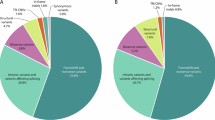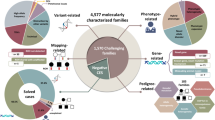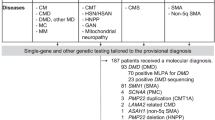Abstract
We examined a Korean family with complex phenotypes characterized by intellectual disability, epilepsy and early-childhood-onset generalized muscle weakness. Since we did not find any abnormality using several conventional genetic tests for detection of chromosomal aberrations, gene copy number variations and mitochondrial gene mutations, we aimed to identify disease-causing genetic alteration(s) in this family. We conducted whole-exome sequencing (WES) in this family. After filtering the WES data, we compared five exome sequences of two affected siblings, one unaffected sibling and the unaffected parents, and we determined the allele frequency of the identified variants in an Asian population. Finally, we selected one candidate variant pair which is unique in the patients and corresponds to an autosomal recessive genetic model. The two affected siblings had the same compound heterozygous variation in the NEB gene encoding nebulin, which was composed of two different missense variants: c.2603T>C (p.L868P) in exon 27 and c.21340C>T (p.R7114W) in exon 143. We confirmed these variations by Sanger sequencing. On the basis of the fundamental role of nebulin in the brain and skeletal muscles, we concluded that this compound heterozygous NEB variation may be a sound candidate for the disease-causing mutation in this family. Since the patients are characterized by generalized muscle weakness together with neurodevelopmental phenotypes, it is suggested that NEB mutations could manifest more diverse phenotypes than those previously described.
Similar content being viewed by others
Log in or create a free account to read this content
Gain free access to this article, as well as selected content from this journal and more on nature.com
or
References
Mullen SA, Carvill GL, Bellows S, Bayly MA, Trucks H, Lal D et al. Copy number variants are frequent in genetic generalized epilepsy with intellectual disability. Neurology 81, 1507–1514 (2013).
Sewry CA Pathological defects in congenital myopathies. J. Muscle Res. Cell Motil. 29, 231–238 (2008).
Ku CS, Naidoo N & Pawitan Y Revisiting Mendelian disorders through exome sequencing. Hum. Genet. 129, 351–370 (2011).
Epi4K Consortium ; Epilepsy Phenome/Genome Project, Allen AS, Berkovic SF, Cossette P, Delanty N et al. De novo mutations in epileptic encephalopathies. Nature 2013; 501: 217–221.
de Ligt J, Willemsen MH, van Bon BW, Kleefstra T, Yntema HG, Kroes T et al. Diagnostic exome sequencing in persons with severe intellectual disability. N. Engl. J. Med. 367, 1921–1929 (2012).
Siripala AD & Welch MD SnapShot: actin regulators II. Cell 128, 1014 (2007).
Siripala AD & Welch MD SnapShot: actin regulators I. Cell 128, 626 (2007).
Labeit S, Ottenheijm CA & Granzier H Nebulin, a major player in muscle health and disease. FASEB J. 25, 822–829 (2011).
Labeit S & Kolmerer B The complete primary structure of human nebulin and its correlation to muscle structure. J. Mol. Biol. 248, 308–315 (1995).
Laitila J, Hanif M, Paetau A, Hujanen S, Keto J, Somervuo P et al. Expression of multiple nebulin isoforms in human skeletal muscle and brain. Muscle Nerve 46, 730–737 (2012).
Lehtokari VL, Pelin K, Sandbacka M, Ranta S, Donner K, Muntoni F et al. Identification of 45 novel mutations in the nebulin gene associated with autosomal recessive nemaline myopathy. Hum. Mutat. 27, 946–956 (2006).
Scoto M, Cullup T, Cirak S, Yau S, Manzur AY, Feng L et al. Nebulin (NEB) mutations in a childhood onset distal myopathy with rods and cores uncovered by next generation sequencing. Eur. J. Hum. Genet. 21, 1249–1252 (2013).
Malfatti E, Lehtokari VL, Bohm J, De Winter JM, Schaffer U, Estournet B et al. Muscle histopathology in nebulin-related nemaline myopathy: ultrastrastructural findings correlated to disease severity and genotype. Acta Neuropathol. Commun. 2, 44 (2014).
Xue B & Robinson RC Guardians of the actin monomer. Eur. J. Cell Biol. 92, 316–332 (2013).
Conde C & Caceres A Microtubule assembly, organization and dynamics in axons and dendrites. Nat. Rev. Neurosci. 10, 319–332 (2009).
Hoffman EP, Brown RH Jr & Kunkel LM Dystrophin: the protein product of the Duchenne muscular dystrophy locus. Cell 51, 919–928 (1987).
Sekiguchi M The role of dystrophin in the central nervous system: a mini review. Acta Myol. 24, 93–97 (2005).
Moizard MP, Toutain A, Fournier D, Berret F, Raynaud M, Billard C et al. Severe cognitive impairment in DMD obvious clinical indication for Dp71 isoform point mutation screening. Eur. J. Hum. Genet. 8, 552–556 (2000).
Lidov HG, Selig S & Kunkel LM Dp140: a novel 140 kDa CNS transcript from the dystrophin locus. Hum. Mol. Genet. 4, 329–335 (1995).
Donner K, Sandbacka M, Lehtokari VL, Wallgren-Pettersson C & Pelin K Complete genomic structure of the human nebulin gene and identification of alternatively spliced transcripts. Eur. J. Hum. Genet. 12, 744–751 (2004).
Donner K, Nowak KJ, Aro M, Pelin K & Wallgren-Pettersson C Developmental and muscle-type-specific expression of mouse nebulin exons 127 and 128. Genomics 88, 489–495 (2006).
Bang ML, Gregorio C & Labeit S Molecular dissection of the interaction of desmin with the C-terminal region of nebulin. J. Struct. Biol. 137, 119–127 (2002).
Tonino P, Pappas CT, Hudson BD, Labeit S, Gregorio CC & Granzier H Reduced myofibrillar connectivity and increased Z-disk width in nebulin-deficient skeletal muscle. J. Cell Sci. 123, 384–391 (2010).
Acknowledgements
This work was supported by a 2012 grant from the Department of Medical Sciences, The Graduate School, Ajou University (M2012C046000028) and a National Research Foundation of Korea grant (NRF) funded by the Korean government (2014 001483).
Author information
Authors and Affiliations
Corresponding authors
Ethics declarations
Competing interests
The authors declare no conflict of interest.
Additional information
Supplementary Information accompanies the paper on Journal of Human Genetics website
Rights and permissions
About this article
Cite this article
Jin, HS., Lee, JB., Kim, K. et al. Identification of the rare compound heterozygous variants in the NEB gene in a Korean family with intellectual disability, epilepsy and early-childhood-onset generalized muscle weakness. J Hum Genet 59, 643–647 (2014). https://doi.org/10.1038/jhg.2014.87
Received:
Revised:
Accepted:
Published:
Issue date:
DOI: https://doi.org/10.1038/jhg.2014.87
This article is cited by
-
Whole-exome sequencing in Tricho-rhino-phalangeal syndrome (TRPS) type I in a Korean family
Genes & Genomics (2017)
-
A reply to a commentary on identification of the rare compound heterozygous variants in the NEB gene in a Korean family with intellectual disability, epilepsy and early-childhood-onset generalized muscle weakness
Journal of Human Genetics (2015)
-
A commentary on identification of the rare compound heterozygous variants in the NEB gene in a Korean family with intellectual disability, epilepsy and early-childhood-onset generalized muscle weakness
Journal of Human Genetics (2015)



